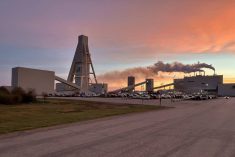North America’s leading crop input provider believes corn and other grain and oilseed prices will be on the rise in the second half of 2015-16.
Jason Newton, head of market research for Agrium, is forecasting a “pretty significant decline” in the corn stocks-to-use ratio, which bodes well for prices.
His analysis is based on a forecast for 88.5 million acres of U.S. corn, a trend line average yield of 165 bushels per acre and flat demand for the crop.
It results in a stocks-to-use ratio of 11.5 to 12 percent, down from the estimated 2014-15 ratio of 13.4 percent.
Read Also

B.C. ostriches culled, CFIA confirms
Ostriches on an embattled Edgewood, B.C. farm have been culled after a prolonged legal battle, the Canadian Food Inspection Agency has confirmed.
“In recent history, when you’re at a stocks-to-use ratio of 11 to 12 percent, in that range, you do tend to see higher prices than where the market is currently,” said Newton.
The ratio would drop below eight percent if growers planted only 87.5 million acres of corn and the average yield fell to 160 bu. per acre, which would be extremely supportive for corn prices.
It would be a return to the levels witnessed from 2010-11 to 2013-14, when the average corn price was $4.46 to $6.89 per bu.
Newton said that is not out of the question because it has been dry in the western corn belt and the northern Plains, where plenty of corn is grown.
The dry conditions have been ideal for seeding, but yields would drop below the trend line if it stays dry during July and August and turns hot during pollination.
The U.S. National Oceanic and Atmospheric Administration is forecasting that drought in North Dakota, South Dakota and Minnesota will persist or intensify through the end of July.
Arlan Suderman, senior market analyst with Water Street Advisory, has almost identical numbers as Newton.
He is forecasting 89.2 million acres of corn, an average yield of 165 bu. and an 11.3 percent stocks-to-use ratio, but he disagrees with the forecast for higher prices.
“I still have a price that is a little bit lower for the marketing year than the current year, though, because we are overall in a commodity deflationary cycle,” he said.
“Keep in mind that this past year, the price is also a little bit higher because some farmers sold early at higher prices before they totally plummeted.”
Suderman agreed that corn prices would likely rise in the second half of the year, even though the average price for the 2015-16 marketing year may be lower.
He is forecasting 1.55 billion bu. of carryout, which is a 41-day supply. December corn futures prices take out the spring high in 90 percent of the years when projected ending stocks are below a 50-day supply.
Newton’s acreage forecast is below the 89.2 million acres that growers told the U.S. Department of Agriculture they would seed in the March 31 Prospective Plantings report.
He was initially thinking it would be closer to 87 million acres because of wet conditions in the southern and eastern U.S.
“But over the last couple of weeks we’ve had really, really rapid planting progress in the western corn belt and central corn belt, which is where the bulk of the acres are,” he said.
That caused Newton to move his estimate back up to 88.5 million acres.
His average yield forecast of 165 bu. per acre is well below the USDA’s projection of 166.8 bu. but higher than the 164 bu. estimate put out by Scott Irwin and Darrel Good, two agricultural economists at the University of Illinois.
The professors based their trend line yield estimate on data from the 1960–2014 period. They believe the USDA’s trend line calculation is flawed because it starts in the drought year of 1988 and uses an approach that assumes with certainty that there will be average weather and planting progress this year.
Contact sean.pratt@producer.com















